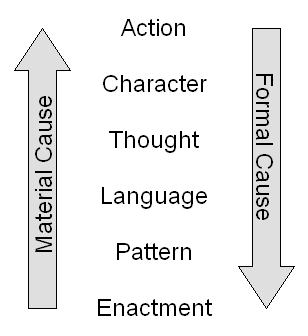
Laurel's Model (1991, p. 51)
Brenda Laurel (1991) begins with Smiley's model, renaming some of the elements to be Action, Character, Thought, Language, Melody, and Spectacle. She describes these elements first in terms of drama, and then expands their meanings to be suitable for all human-computer activities (such as computer-based interactive narratives).
Starting at the lowest levels, Laurel begins by defining Spectacle as "everything that is seen" and Melody as "everything that is heard". However, this does not fit cleanly into the causal hierarchy since Spectacle does not form the basis of Melody. Also, this emerging neo-Aristotelian model does not seem to allow for visual signals to travel "up" the hierarchy to become the basis of Language and the understanding of the drama.
So Laurel renames Spectacle to Enactment and redefines it to mean all the sensory dimensions of the represented action--visual, auditory, tactile, and any others. From these sensations, the user constructs Patterns. Language now does not mean only spoken human language, but any "selection and arrangement of signs, including verbal, visual, auditory, and other nonverbal phenomena when used semiotically" (Laurel 1991, p.50). Thought and Character remain largely unchanged, though for Laurel they may arise from computer-based, rather than solely human, origins.
Though Laurel has overhauled the bottom half of the hierarchy in an attempt to fit the demands of the causal connections, we shall see that a number of inadequacies still remain.
|
Argax Project : Dissertation :
A Rough Draft Node http://www2.hawaii.edu/~ztomasze/argax |

|
Last Edited: 08 Apr 2011 ©2006 by Z. Tomaszewski. |